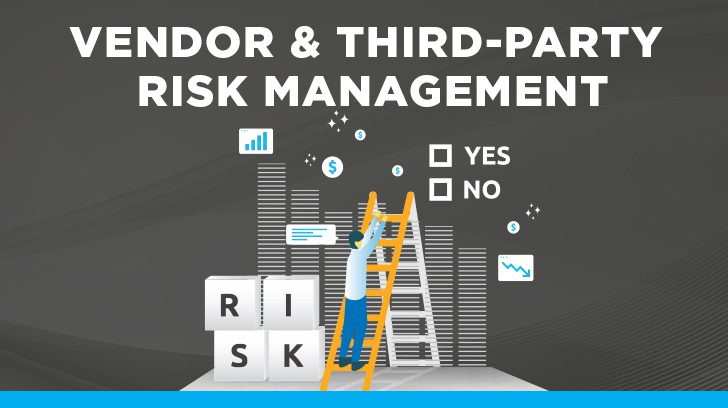In the ever-evolving realm of business, where external vendors and third-party collaborations are pivotal for enhancing efficiency and innovation, the significance of effective vendor and third-party risk management has never been more pronounced. Additionally, it has become the norm for companies to rely on third parties to provide critical operational functionality for a business. As we head into the new year, marked by technological leaps, regulatory shifts, and heightened global interconnectedness, organizations are compelled to recalibrate their risk management strategies to proactively counter emerging threats. This article delves into best practices for vendor and third-party risk management, highlighting the evolution of the landscape we have seen in recent years.
Understanding the Vendor/Third-Party Risk Management Process
A vendor/third-party risk management process is, at its core, a guiding framework allowing organizations to conduct thorough due diligence during the vendor selection process. It also ensures the ongoing monitoring of current vendors on a periodic or continuous basis.
Given that most organizations heavily depend on vendors for a myriad of services, some of which are operationally critical (e.g., AWS), the goal of any vendor risk management process is to oversee vendor relationships, guarantee adherence to commitments, and minimize risks associated with third-party engagements.
What Exactly is A Third-Party Vendor Risk?
Third-party risks are simply the risks that arise from doing business with a vendor. Some examples include additional risk related to exposure of your data if you have a vendor who is handling, processing or storing your data. Another risk scenario could be an outage risk – if you are hosting your infrastructure at a third-party data center, you would certainly want to validate whether or not they have the appropriate physical and environmental security controls in place. This protects your infrastructure in the event of a disaster. Outlined below are some of the typical ways in which organizations can identify and then manage vendor risks.
As part of your overall risk assessment policy and process, vendor risks should be noted within the overall risk register, which is a list of all of your organization’s risks with outlined details on when and how they are being addressed.

Best Practices in Vendor & Third-Party Risk Management
As organizations brace for the challenges ahead, adopting best practices in vendor and third-party risk management is not just beneficial but imperative. The following key strategies will empower companies to adapt to the ever-changing regulatory environment and security risks:
- Thorough Risk Assessments: Conduct comprehensive risk assessments to identify and evaluate potential risks linked with third parties, encompassing cybersecurity, compliance, financial considerations, and other factors impacting the organization.
- Prioritize Due Diligence: Emphasize due diligence when selecting vendors and third parties. Evaluate their security practices, financial stability, regulatory compliance, and overall reliability. Establish vendor selection criteria aligned with your organization’s risk tolerance and objectives.
- Clear Vendor Contracts: Ensure vendor contracts transparently outline expectations, responsibilities, and compliance requirements. Include clauses related to data protection, security measures, and incident response. Regularly review and update contracts to align with evolving regulations and organizational needs.
- Collaborative Cybersecurity Resilience: Collaborate with vendors to enhance cybersecurity resilience. Establish joint incident response plans and conduct tabletop exercises for a coordinated response in the event of a security incident. Regularly test and update these plans to address emerging threats.
- Monitor Emerging Technologies: Stay vigilant about emerging technologies and their implications for vendor risk management. Assess risks associated with these innovations and collaborate with vendors to implement appropriate security measures.
- Stay Aware of Regulations: Maintain awareness of evolving data protection and privacy regulations. Regularly review and update vendor risk management processes to align with changing compliance requirements. Consider the global nature of regulations and tailor your approach accordingly.
- Cultivate a Culture of Risk Awareness: Foster a culture of risk awareness and accountability across your organization. Ensure that employees are educated about the importance of vendor risk management and their role in maintaining a secure and compliant ecosystem.
- Continuous Monitoring and Auditing: Implement continuous monitoring and auditing processes to track the performance and security posture of vendors. Regularly assess compliance with contractual agreements and industry standards. Automated tools can aid in real-time monitoring, providing a proactive approach to risk mitigation. More on this topic below.
The foundation of these best practices lies in a well-documented vendor risk management policy. This policy provides the framework for consistently evaluating, onboarding, and managing the lifecycle of vendor relationships. Organizations can find template guides for crafting such policies at security organizations like NIST, SANS, and others.

Common Contractual Agreements When Sharing Data with Vendors or Third Parties
Sharing data with vendors and third parties necessitates the use of agreements like Business Associate Agreements (BAAs), Data Processing Agreements (DPAs), and Standard Contractual Clauses (SCCs). Understanding their nuances is crucial:
- BAAs (Business Associate Agreements): Contracts of trust where the controller entrusts the processor with handling personal data. It sets meticulous instructions for data protection, deletion protocols, and access limitations during the data’s custody.
- DPAs (Data Processing Agreements): Collaboration agreements among joint controllers, delineating roles in data ownership, access, decision-making, and ensuring joint accountability for compliance. It prevents finger-pointing during the shared data processing journey.
- SCCs (Standard Contractual Clauses): Essential gateways for international data transfers, acting as passports when personal data moves beyond EU borders. They help to promote a consistent level of data protection abroad (e.g., the GDPR), complete with security checkpoints, access restrictions, and onward transfer controls.
Choosing the right agreement hinges on the specific context. BAAs are ideal for domestic partnerships, ensuring data protection under the processor’s care. DPAs come into play when collaboration requires shared control, providing a roadmap for seamless joint efforts. For international data transfers, SCCs act as essential travel documents, ensuring data receives the same level of care abroad.
Effectively Managing & Monitoring Vendor Risks
Once a new vendor has been vetted, and risk assessments completed with necessary agreements signed, the subsequent critical step is monitoring—integral to any robust organizational risk management program. The approach to monitoring should be tailored to the level of risk associated with the vendor or third party. Incorporate various mechanisms into your organization’s vendor policy for effective monitoring:
- Regularly review SOC 2 reports (type 1 or type 2), typically available annually.
- Utilize continuous monitoring tools for early detection of compromise indicators, or other risk types.
- Review and reconcile output reports.
- Conduct periodic discussions with the third party.
- Make regular site visits to the third party.
- Test controls at the third party through the internal audit function.
- Monitor external communications, including relevant customer complaints.
- Repeat the vendor security questionnaire periodically.
Organizations can select a combination of these mechanisms for vendor monitoring. Regular reviews are crucial, especially when significant changes occur to services supporting the organization.
External audit reports, such as SOC 2 reports, provide a comprehensive understanding of a vendor’s overall security posture. Key considerations include validating the audit’s scope, addressing significant issues or exceptions, and reviewing complementary user entity controls (CUECs) to ensure alignment with the vendor’s commitments. This approach ensures a holistic assessment of vendor risks and enhances the overall security resilience of the organization.

Risk-Based Approach to Vendor Monitoring
Applying the processes and best practices to all vendors in your technology ecosystem may seem overwhelming. Adopting a risk-based approach, by categorizing or ranking vendors based on your organization’s objectives, can help prioritize efforts. Focus more on vendors with the highest risk to your organization, such as those holding the personal data of customers, by monitoring them regularly or continuously. Conversely, vendors posing lower risks, like a training platform storing limited or no customer or employee data, can undergo less frequent monitoring. This risk-based categorization process should align with your organization’s overall information security risk management objectives.
Summary
The landscape of vendor and third-party risk management has undergone significant evolution in the past five years, driven by technological advances, regulatory changes, and a dynamic global business environment. Looking ahead, organizations must adopt a proactive and adaptive approach to manage risks associated with their vendor ecosystems. Through comprehensive risk assessments, due diligence in vendor selection, and a commitment to continuous monitoring, organizations can effectively navigate the complexities of vendor and third-party relationships. This not only safeguards their data and reputation but also strengthens their overall business resilience in the face of ever-changing security threats.
Linford and Company has extensive experience working with organizations to define their vendor risk management processes. Please contact us if you would like to learn more about how we can help you.
This article was originally published on 3/17/2020 and was updated on 1/3/2023.

John has over 15 years of experience focused on IT security, governance, risk, compliance, and privacy. He started his career in 2006 with Protiviti and later went on to run IT audit and GRC functions for several Fortune 500 companies within the financial services, energy, hospitality, and software industries. John is also a certified information systems auditor (CISA) and holds a Bachelor of Science degree in Management from Colorado State University.



